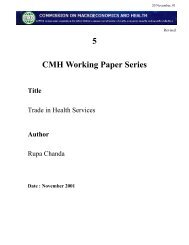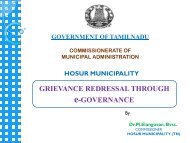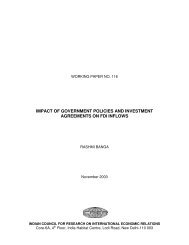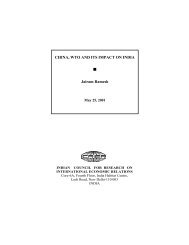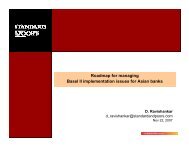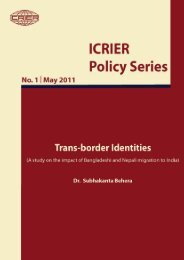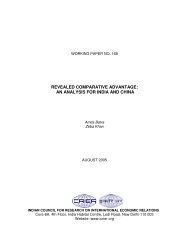prevention and control of non-communicable diseases - icrier
prevention and control of non-communicable diseases - icrier
prevention and control of non-communicable diseases - icrier
You also want an ePaper? Increase the reach of your titles
YUMPU automatically turns print PDFs into web optimized ePapers that Google loves.
Issues in the Delivery <strong>of</strong> Chronic Care<br />
Chronic Care <strong>and</strong> Optimisation <strong>of</strong> Available Resources<br />
Since the dem<strong>and</strong>s <strong>of</strong> chronic care are many <strong>and</strong> the available resources <strong>and</strong><br />
restricted, efforts to optimise the use <strong>of</strong> those resources should include the following<br />
elements.<br />
Identifying a Menu <strong>of</strong> Core Components for Providing an ‘Essential Package’ <strong>of</strong> Chronic<br />
Care with Possible Extension to an ‘Optimal Package’.<br />
A list <strong>of</strong> core (essential) <strong>and</strong> other (optional) components <strong>of</strong> chronic care needs to<br />
be prepared, as appropriate to the context <strong>of</strong> each state or (where feasible) <strong>of</strong> each<br />
district. The delivery <strong>of</strong> the ‘essential’ package must be the immediate objective <strong>of</strong> the<br />
health care system, while the extent to which the ‘optimal’ package can be delivered is<br />
subject to the availability <strong>of</strong> resources.<br />
Since resource constraints are especially severe in the developing countries like<br />
India <strong>and</strong> programmes for delivery <strong>of</strong> chronic care at an inception, it is essential to<br />
identify a set <strong>of</strong> core or ‘essential’ components that constitute the minimal agenda <strong>of</strong><br />
chronic care. These will have to be chosen based on cost-effectiveness <strong>and</strong> impact on<br />
population attributable risk, so as to optimise the use <strong>of</strong> available resources. In addition a<br />
set <strong>of</strong> other ‘optimal’ components may also be identified for extending this agenda if<br />
adequate resources become available. A suggested list is provided in Table VII. This list<br />
has to be customised, as appropriate to each regional context. For example, in regions<br />
where stroke is the predominant contributor to cardiovascular mortality, algorithms for<br />
the management <strong>of</strong> stroke may need to be included in the ‘essential’ package <strong>of</strong> chronic<br />
care.<br />
Integration <strong>of</strong> these Services into Various Levels <strong>of</strong> Health Care<br />
The 'essential'package <strong>of</strong> services must be integrated into the existing health care<br />
infrastructure, by involving care providers, <strong>of</strong> all categories at various levels <strong>of</strong> care.<br />
15





